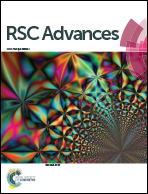Domino Knoevenagel condensation–Michael addition–cyclization for the diastereoselective synthesis of dihydrofuropyrido[2,3-d]pyrimidines via pyridinium ylides in water†
Abstract
A green method for the diastereoselective synthesis of dihydrofuropyrido[2,3-d]pyrimidines via the reaction of 6-amino-1,3-dimethyl pyrimidine-2,4(1H,3H)-dione, aldehydes and 1-(2-oxo-2-phenylethyl)pyridin-1-ium bromides as a pyridinium ylide base on an organocatalyst assisted domino Knoevenagel condensation–Michael addition–cyclization is investigated. To the best our knowledge, employing 6-amino-1,3-dimethyl pyrimidine-2,4(1H,3H)-dione for the synthesis of dihydrofuropyrido[2,3-d]pyrimidines has not been report yet. This synthesis serves as a nice addition to group-assistant-purification (GAP) chemistry in which purification via chromatography and recrystallization can be avoided, and the pure products were obtained simply by washing the crude products with ethanol.
![Graphical abstract: Domino Knoevenagel condensation–Michael addition–cyclization for the diastereoselective synthesis of dihydrofuropyrido[2,3-d]pyrimidines via pyridinium ylides in water](/en/Image/Get?imageInfo.ImageType=GA&imageInfo.ImageIdentifier.ManuscriptID=C3RA45795H&imageInfo.ImageIdentifier.Year=2014)

 Please wait while we load your content...
Please wait while we load your content...